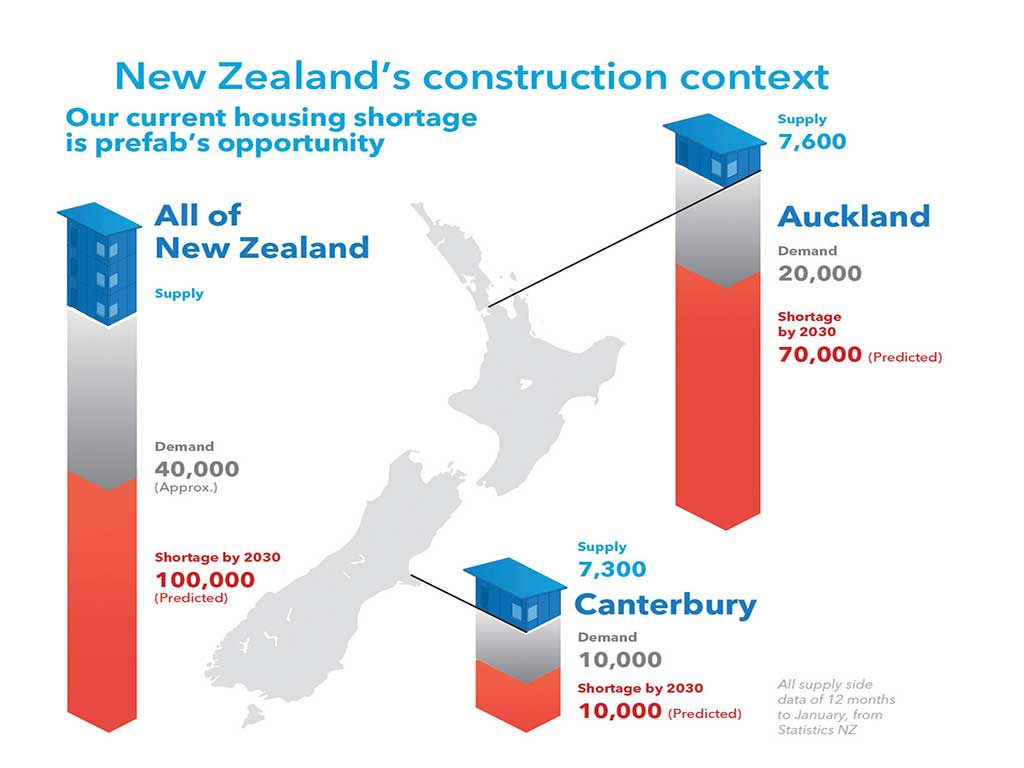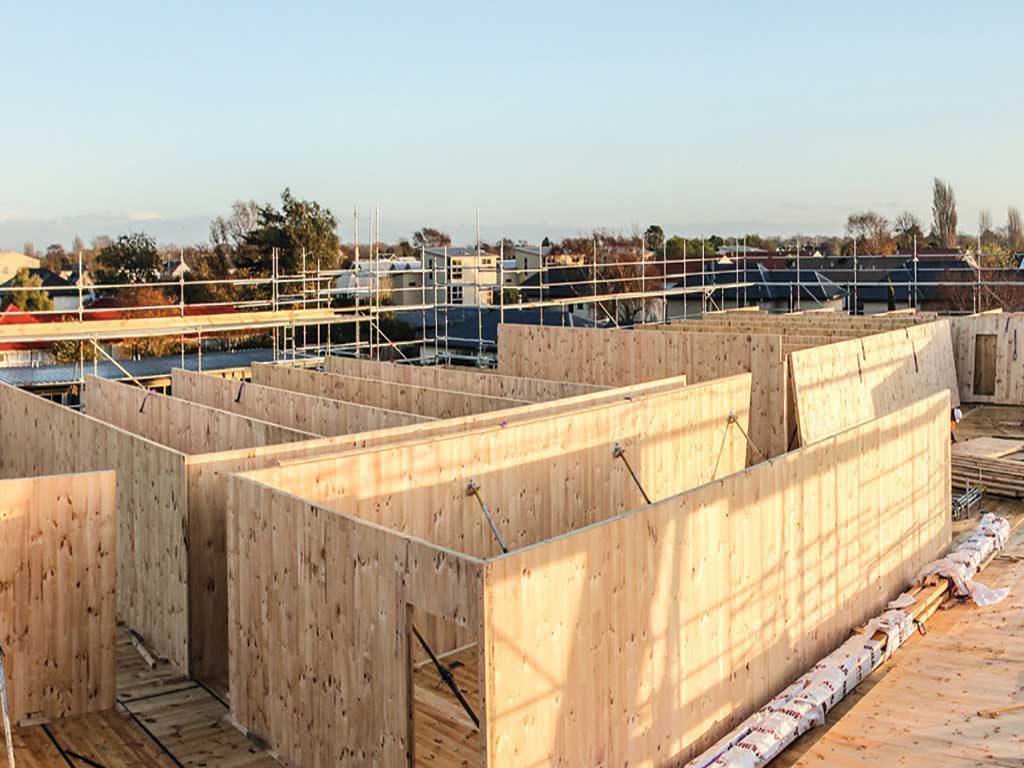THE TRANS-TASMAN PERSPECTIVE
PAMELA BELL, CEO OF PREFABNZ, NEW ZEALAND’S PRE-FAB INDUSTRY HUB, SHARES KEY DATA POINTING TO THE RISE OF PREFAB IN THE COUNTRY’S CONSTRUCTION SECTOR.
New Zealand’s construction pipeline is growing at a forty-year high towards an unprecedented peak of $37billion (NZD) next year. Residential growth will remain strong, with a recent announcement by Auckland’s Council to enable over 400,000 new homes over the next 30 years.
Prebuilt construction makes up over 25% of all buildings by value and is poised to deliver into this expanding medium-density housing market. A growing range of engineered timber-based panels and components, like cross-laminated timber and glulam, alongside open-source solutions such as the UNIpod, will be part of this changing built environment.
NZ’S PREFAB HUB
PrefabNZ is the hub for prebuilt and innovative construction. Established in 2010, this non-profit member-based organisation acts much like prefabAUS and is comprised of 250 organisations representing architects, engineers, manufacturers, distributors, builders, researchers and other building professionals.
PrefabNZ is focused on delivering timely relevant information, education and advocacy for increased uptake of a wide range of offsite construction methodologies, from pieces and parts to panels, pods and complete transportable buildings. The merits of using prebuilt are expressed in quality, time, cost, design, sustainability and health + safety advantages, with a 15% cost saving being a common measure (PrefabNZ Value Case 2014).
www.prefabnz.com/News/ValueCase
NEW ZEALAND’S HOUSING BOOM
New Zealand’s booming construction pipeline is focused on residential growth, representing more than half of all building activity. Nearly half of all dwelling approvals will be for Medium-Density Housing (MDH) by 2021.
The country’s largest city, Auckland, is the focus of this boom, with the South Island’s Queenstown coming a close second. Both cities now report average house prices of $1 million NZD. Auckland’s residential construction boom is forecast to peak in 2018 at $17 billion NZD. Nearly 100,000 new dwelling consents are forecast in Auckland from 2014 to 2021, by which time MDH will have overtaken detached dwelling approvals.
PREFAB GROWTH IN NEW ZEALAND
New Zealand has been home to the indigenous Maori people for many centuries, with Europeans settling relatively recently in the 1800s. Our prefab roots can be seen in both the bundling of Raupo (Bulrush) at the edges of wetlands into wall panels by Maori, as well as English colonials bringing their homes with them from England to NZ as pre-cut timber pieces.
Our history of prefab mirrors other industrialised nations, with a surge of activity post World War II and the influence of new materials and technologies in the 1960s and 1970s. See the image of the De Geest Construction factory started in a small rural settlement by a Dutch émigré, producing hundreds of houses for the hydro-power dam construction towns in the 1970s. They used ground-breaking panel and pod techniques along with full transportable housing to produce towns like Twizel that remain today.
More recently, there has been a resurgence of interest in architectdesigned offsite construction made deliverable by digital technologies such as Building Information Modelling (BIM) and file-to-factory digital manufacture.
In 2013, the construction industry was estimated to create $2.95 billion NZD worth of prefabrication, mostly in the form of wall framing, roof trusses, windows and joinery. This is equal to 25% of the value of all consented building projects and indicates the market is already relatively substantial, but limited to a small number of components (BRANZ SR312, Norman + Page, 2014).
Certainly the benefits of offsite construction to the New Zealand market are clear. It can remove $25,000 to 40,000 NZD off each home. Prefabrication can reduce up to 60% of time at site through limiting weather damage, reducing financing costs, enabling completion earlier and increasing client satisfaction (PrefabNZ Value Case 2014).
PREBUILT TECHNOLOGIES
Almost all New Zealand new residential buildings use pre-nail timber roof trusses and wall frames. Many rural secondary agriculture dwellings and coastline holiday homes (known as baches in the north and cribs in the south) are transportable or complete prefab buildings. Interest in panelised and volumetric production is growing, with several factories established in the last few years that manufacture timber-based panels, either as pre-cut custom frames using German machinery technology, or as Cross-Laminated Timber (CLT) panels. Structural Insulated Panel (SIP) use is also growing with imported and locally made options both available. These are particularly popular in the South Island where the colder climate reigns supreme.
SHOW-AND-TELL PREBUILT
After the Canterbury earthquakes, PrefabNZ set up the first HIVE Home Innovation Village to demonstrate ten different prefabricated residences side-by-side for over two years. The next step is to develop an online interactive HIVE so that innovative projects can be experienced virtually. www.prefabnz.com/HIVE/
The continued growth of retirement villages and the high need for cost-effective social housing mean more innovative pre-packaged design and construction solutions are needed. PrefabNZ recently launched a design competition for a UNIpod, an open-source universal bathroom and kitchen pod that can be made nationwide anywhere by anyone for multi-unit developments.
www.prefabnz.com/News/UNIpodresults/ and www.prefabnz.com/News/UNIpodlaunch/ and www.prefabnz.com/News/UNIpodlaunchCoLab/ ■
For more information or to share your views,
contact: pam@prefabnz.com
www.prefabnz.com










